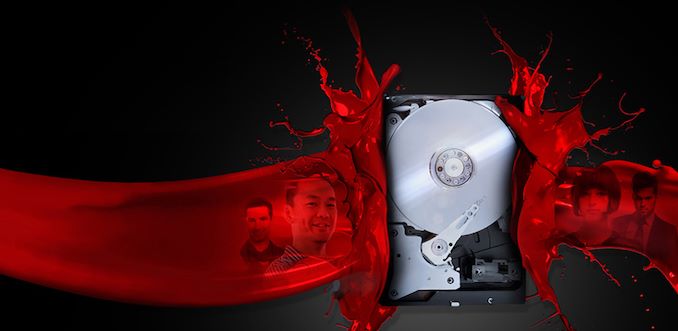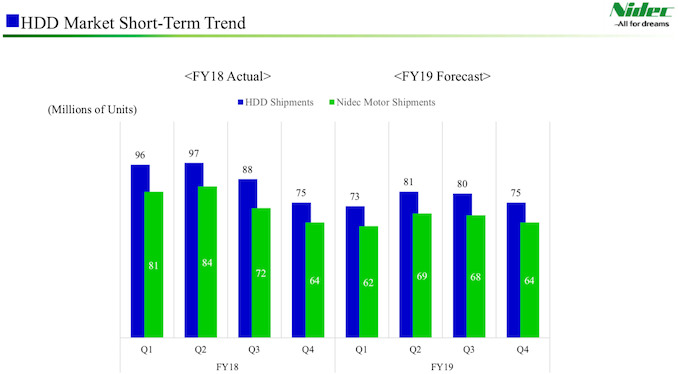Shipments of PC Hard Drives Predicted to Drop By Nearly 50% in 2019
by Anton Shilov on May 3, 2019 12:00 PM EST
According to a new financial presentation from Nidec, a Japanese motor manufacturer who is responsible for around 85% of all HDD spindle motors, the company believes that shipments of hard drives for PCs will drop significantly this year. Citing numerous ongoing trends, the motor maker is preparing for HDD motor sales to drop by around 50% year-over-year for 2019. Meanwhile the company also expects sales of other types of HDDs to slow, but not as drastically. In fact, unit shipments of hard drives for datacenters are projected to increase a bit.
According to Nidec's data, unit sales of hard drives declined by around 43% from 2010 to 2018, going from around 650 million units in 2010 to 375 million units in 2018. And it looks like sales will continue to drop in the coming years. Recently Nidec revised its HDD shipment forecast downwards from 356 million drives to 309 million drives in 2019, which will further drop to 290 million units in 2020. The recent drops in HDD shipments have already forced Nidec to optimize its HDD motor production capacities and repurpose some capacity to other types of products.
Shipments of PC HDDs have been hit the hardest among all types of HDDs due to a combination of general market weaknesses and the transition of notebooks to SSDs. According to Nidec, shipments of PC HDDs decreased gradually from 289 million drives in 2013 to 124 million devices in 2018. However, this year sales of hard drives for PCs will drop sharply, going from 124 million devices in 2018 to 65 million units in 2019, or by around 48%.
Meanwhile shipments of hard drives for broader consumer electronics devices is expected to decrease from 77 million HDDs in 2018 to 70 million in 2019. This is likely being driven by lower sales of current-generation consoles, surveillance systems, and other devices.
There is a bright spot in the HDD market however: external HDDs as well as nearline hard drives for datacenters are both looking strong. Shipments of the former will stay flat at around 100 million units, whereas sales of the datacenter drives are expected to increase to 54 million units, according to Nidec. Conversely, sales of enterprise-class drives – which Nidec counts separately from datacenter drives – are expected to decline a bit as mission-critical applications migrate to SSDs.
Amongst all of these shifts in HDD sales volumes, it is noteworthy that the leading hard drive makers have indicated that while unit sales of nearline and surveillance HDDs may stay more or less flat (or even drop), their capacities and ASPs are getting higher.
Nidec controls the lion’s share of the market for HDD spindle motors, so its projections are rather valuable and definitely worth checking out. Especially as the company expects to maintain its high market share throughout this calendar year.
Related Reading:
- Western Digital: Over Half of Data Center HDDs Will Use SMR by 2023
- Toshiba's HDD Tech Roadmap: A Mix of SMR, MAMR, TDMR, and HAMR
- Western Digital to Demo Dual-Actuator HDDs Next Week: Double the Actuators for Double the Perf
- 18 TB HDDs: Toshiba Collaborates with Showa Denko for MAMR HDDs
- HOYA Starts to Build Next-Gen HDD Glass Substrate Production Facility
- State of the Union: Seagate's HAMR Hard Drives, Dual-Actuator Mach2, and 24 TB HDDs on Track
Source: Nidec












73 Comments
View All Comments
DanNeely - Friday, May 3, 2019 - link
On the consumer side, because some users do need more than 128/256gb; and outside of occasional crazy sales 1 tb of spinning rust is still significantly cheaper than a 1tb ssd. OTOH the price gap is continuing to shrink while the minimum viable ssd size keeps going up; which is driving sales of consumer drives ever downward. On the laptop side the quest for thin is helping some too.I'm honestly more surprised about the resilience of enterprise HDDs. Since they're breaking out data center drives, these are presumably 10/15k RPM SAS models; and those only ever make sense in cases where you're IO limited. AFAIK SSD equipped systems generally crush 10/15k RPM hdd ones in total cost/performance in IO bound workloads; so I was expecting sales to collapse toward RAID replacements for old systems and the like.
peevee - Friday, May 3, 2019 - link
"On the consumer side, because some users do need more than 128/256gb; and outside of occasional crazy sales 1 tb of spinning rust is still significantly cheaper than a 1tb ssd."Not significantly in a $500+ new computer (and most are more than that). While speed improvements in the most operations people actually wait for (like launching programs, searching something on a disk, opening files) are easily 10x faster. With an HDD as a main drive, all the improvements in CPUs, memory speed etc over the last 2 decades are complete waste. It is literally (in terms of access speed ratios) like using a 1GHz Pentium III from 1999 with a cassette main storage from a 1970s 8080 home computer. Nobody with $1000 for a new PC was THAT stupid back then, what happened?
freeskier93 - Friday, May 3, 2019 - link
Why do you keep assuming everyone who needs a lot of storage uses the HDD as their main drive? Small SSD for the OS and programs then HDD for data is a pretty common setup.khanikun - Monday, May 6, 2019 - link
He can't think outside of his little box for some reason. My gaming rig has 512 GB m2 SSD for OS, two 512 GB sata SSD (raid 0) for programs, two 512 GB sata SSD (raid 0) for games, and four 4 TB HDDs for storage.Even my file server uses a 1 TB m2 SSD for OS and programs, with eight 6 TB HDDs for storage. Adding in four more 6 TB HDDs soon.
I'm not buying ridiculously expensive SSDs for mass storage. Nothing about it is going to give me any benefits. I'm limited by the network when transferring files between computers and even the data sitting locally is nothing more than mp3s or videos. Where an ssd isn't going to provide any benefits when listening to music or watching a video.
peevee - Monday, May 6, 2019 - link
Most PCs sold are laptops, and even most desktops have just 1 drive.Don't get me wrong, I use HDD just like you described myself, but it is 2011 self-build.
Today the storage configuration which makes sense is PCIe x4 NVMe SSD (1TB), and MAYBE big cheap SATA SSD (or 2) as a 2nd (3rd) drive if you are into home-made video.
The problem is that very few self-build, and manufacturers still offer HDDs in basic configurations of mainstream desktops and even laptops, without disclosing that it degrades real-life performance by a decade or more.
khanikun - Tuesday, May 7, 2019 - link
There is no such thing as a big cheap SATA SSD. They're either cheap and small storage amount or expensive with large storage amount. A 4 TB SATA SSD is going to run you at minimum $500-1200, while a 4 TB hdd is $100-$180.Ananke - Friday, May 3, 2019 - link
With Big Data you also have data migration, which doesn't simply happen without archive and mirroring, because you don't want ti risk corruption or failure during database migrations. Therefore, even you may have a 50 TB SSD server, you still need another 65-80 TB migration storage. Enterprise/workstation 50TB is $250-400k for the device, around $120k for the storage array. Better to mirror it with HDDs....Lord of the Bored - Saturday, May 4, 2019 - link
I hereby propose that if we are going to keep referring to hard disks as "spinning rust", we also need to refer to flash storage as "quartz shards".fazalmajid - Friday, May 3, 2019 - link
NAND flash SSDs are not an archival medium, they lose data if left unpowered for more than a year or so. Thus you still need HDDs for backup.RobATiOyP - Friday, May 3, 2019 - link
Ummm, well I turned on 2 machines with consumer SSD's one an early consumer OCW 64GiB SSD which never really worked smoothly. Both OSes booted up fine and updated as best they could. I don't think the flash lostone byte in 3 years.